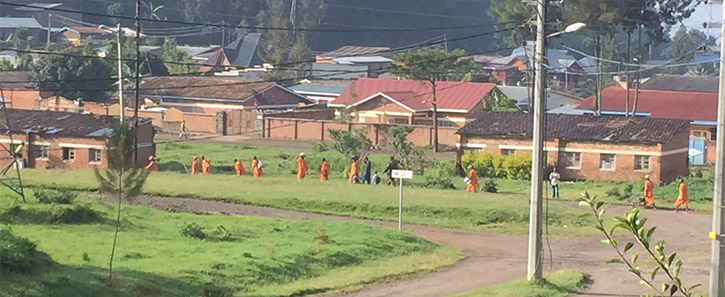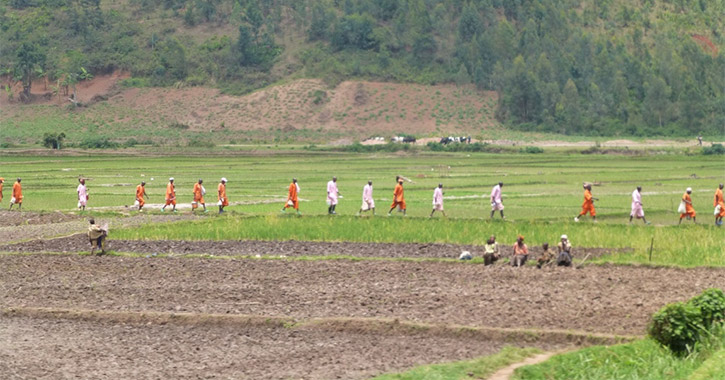Day 2 of the Police Strategic Command Course, Rwanda
Editorial Advisory Panel Member Roger Gomm describes how the second day of the course involved looking at the role and requirements of the Gold/Strategic Commander.
Gomm is in Musanze, Rwanda, to deliver a two-week 'Policing Operations' module to the SE & Central African Police Strategic Command Course at the National Police College, for the third year. This year’s course has students from South Sudan, Kenya, Ethiopia, Gambia, Burundi, Namibia and Rwanda.

Today’s picture shows inmates from the local prison, dressed in orange. Prisoners in Rwanda are not hidden behind bars - see below for more details about how Rwanda justice system is dealing with those who took part in the 1994 genocide
This second day of instruction was not intended as a discussion of leadership in general. Rather its purpose was to discuss, define and briefly examine the functions of leaders when responding to or managing serious incidents and events. We were not looking at the generic attributes, traits or characteristics of leaders. The focus of this session was on what strategic commanders actually have to do.
The location of the Gold/Strategic Commander when an incident occurs provoked some useful debate as it always does with police officers, especially when looking at current and best practice!
One of the key functions we spent some time on was creating and maintaining situational awareness or understanding the situation from a strategic perspective, recognising the risk, potential long term and wider impacts, and long term consequences. This process developed much discussion and group activity.
Justice after the genocide
Prisoners in Rwanda are not hidden behind bars. Instead they complete manual labour projects in their communities, such as building homes for genocide survivors, schools, police stations, and parks.
Convicted prisoners wear orange jumpsuits to distinguish themselves from the prisoners awaiting trial, who are clad in pink.

Putting the offenders in jumpsuits is part of the process of moving on from the genocide of 1994, which engulfed the entire country in violent conflict. The genocide lasted 100 days and approximately 800,000 people were killed, with many more terrorised and displaced.
While some of the worst offenders are spending their lives in prison, the Rwandan Government came to the conclusion that giving harsh life sentences to all those involved in the genocide of 1994 would only encourage the cycle of revenge killing. Promoting restorative justice, the Rwandan established a system of Gacaca courts, based on the traditional court system of Rwanda.
Gacaca literally means “justice on the grass.” In these community courts, the accused were tried by the communities in which they committed their crimes.
Both ‘genociders’ and survivors were involved in the process, which was meant to simultaneously encourage repentance, and forgiveness from survivors as well as determining community sentences where appropriate. In this system, perpetrators were encouraged to admit their crimes to support the community recovery.
Roger Gomm, CRJ Editorial Advisory Panel
Roger Gomm, 29/04/2015